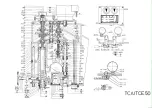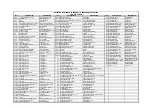
TCA-TCE-50-Textos
3
tensión adecuada, una vez esto, introducir el tornillo en el alojamiento de sujeción del muelle. S/dibujo adjunto nº 1
(página 4)
•
MANTENIMIENTO
Los trabajos de mantenimiento consisten en el engrase manual o semiautomático de los diferentes mecanismos, la forma
de efectuarlos y la periodicidad de las mismas está indicado en este libro de instrucciones (página 8).
•
OPERACIONES QUE PUEDAN OCASIONAR ALGÚN NIVEL DE RIESGO.
•
TALADRADO.
1. Todas las piezas a mecanizar como los elementos de sujeción deberán estar siempre bien amarrados a la mesa de
trabajo.
2. Todos los mandos de sujeción de soporte, mesa y columna deberán estar siempre bien bloqueados.
3. Se deberán tener en cuenta siempre todas las placas indicadoras de peligro.
4. El mando del dispositivo del expulsor automático de la herramienta deberá estar siempre en la posición "A", s/dibujo nº 2
(página 4).
5. No trabajar en avance automático, mientras el mando nº 3, esté en la posición "B", S/dibujo nº 2 y 3 (página 4).
6. Se deberá tener siempre en cuenta, tanto trabajando en avance manual como en automático, los posibles golpes que
pueda ocasionar el mando nº 14 (página 9) debido a la energía elástica del muelle de recuperación del eje principal.
•
REPARACIÓN Y MANTENIMIENTO.
Todas las operaciones de reparación y mantenimiento, han de realizarse por personal capacitado y tomando las
medidas de seguridad pertinentes.
•
DEPOSITO DE REFRIGERANTE
La base del taladro se utiliza como depósito de refrigerante, que tiene una capacidad de:
TCA.50
13 litros
IMPORTANT
: Before starting with the installation, you should read this operation handbook carefully.
STEPS TO FOLLOW
•
Machine handling and transport
•
Machine start-up.
•
Operation and adjustment.
•
Most important maintenance and repairs operations.
DESCRIPTION OF THE ABOVE STEPS
•
MACHINE HANDLING AND TRANSPORT.
Machine handling from floor-transport-floor or another transport, is carried out with suitable cranes and lifting auxiliary items,
which must assure enough loading capacity to lift the load safely.
This handbook also shows how the handling operations must be performed (see page 17).
•
MACHINE START-UP.
The machine should be installed in a place, which is protected against inclement weather. The foundation should have
enough capacity to support the weight of the machine and it should also be tough enough to support the machine without
inadmissible deformations, which prevent the correct function of the machine. Besides you should avoid the transmission of
any vibration to the floor or structure of the place.
You should provide enough room around the machine to ease the operation, handling of materials, machine maintenance
and staff safety.
Before the start up of the machine, please note the following:
•
Skilled workers, equipped with the correct clothing and tools should carry out the start-up.
•
Make sure that the machine has enough space with or without auxiliary tables to allow and ease the safe, working, and
maintenance and repair operations.
•
Ensure that the machine foundation and vibration proof system is adequate. (page 9).
•
Check the supply voltage.
•
Make sure that the current to be used is the same as the drilling voltage.
•
The main switch nr.1 (page 4) is installed in the electric cabinet, as per drawing nr.3 (page 4). - On machines with three
phase connection, the connection should be EARTH, RST and if required N (N= Neutral).
•
Before checking the turning sense, please make sure that the lever nr.1 (page 4) is in "RELEASED" position. To see that,
the main spindle has to displace manually by means of the command nr.2, as per drawing nr.3 (page 4). See point 7 and 8.
•
When the machine is delivered with the electromagnetic clutch (EMEL), the main switch IG, as well as the connections nr.5
and the current entry nr.6, are placed in the electrical cabinet nr.4, as per drawing nr.3 (page 4).
•
Attention, take special care of testing the main spindle turning sense, before running the tapping system by lead
screw (Extra equipment).



















